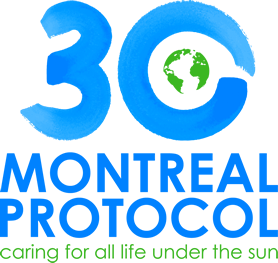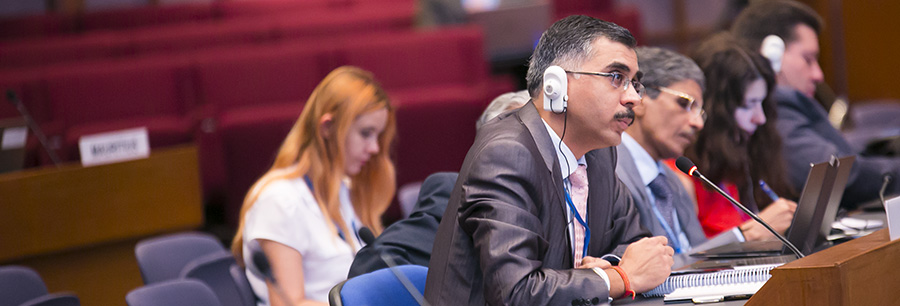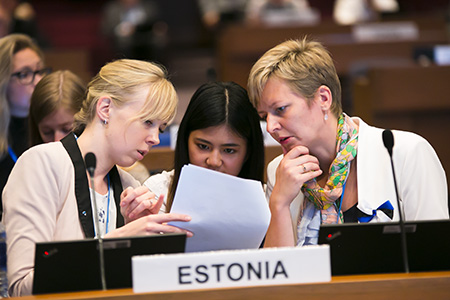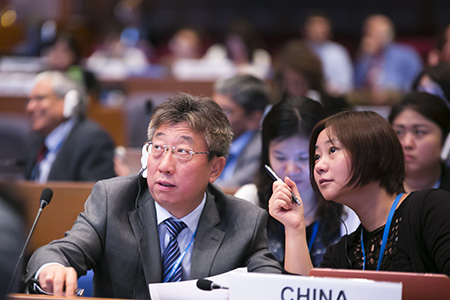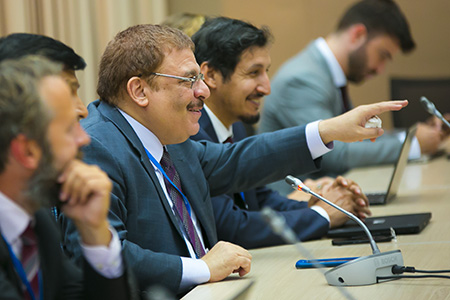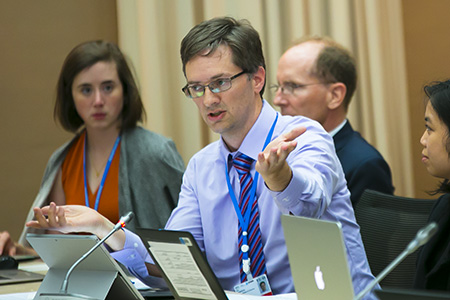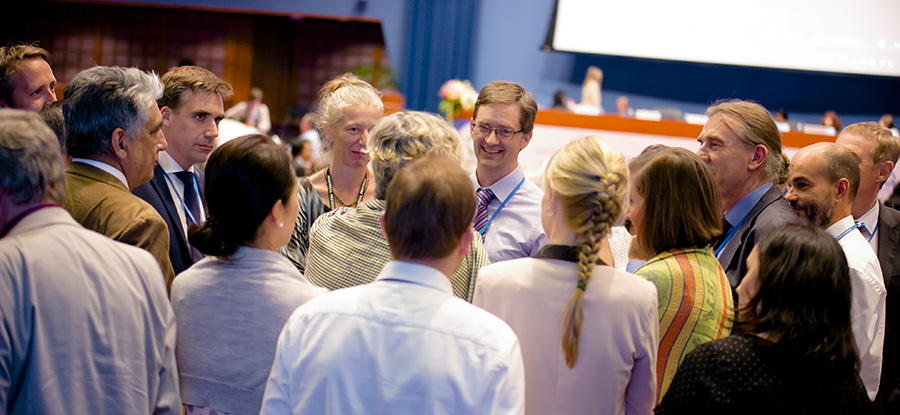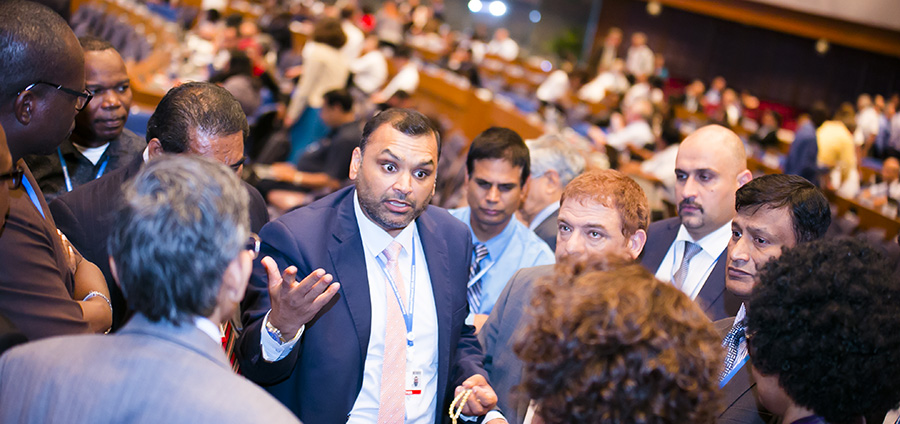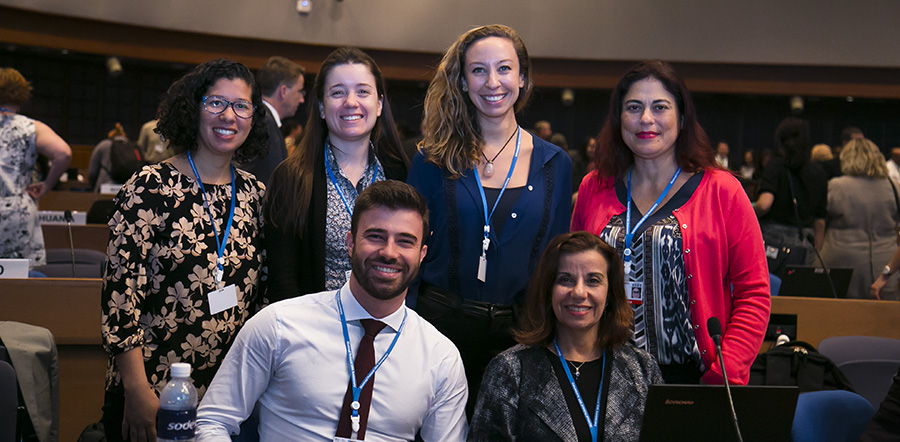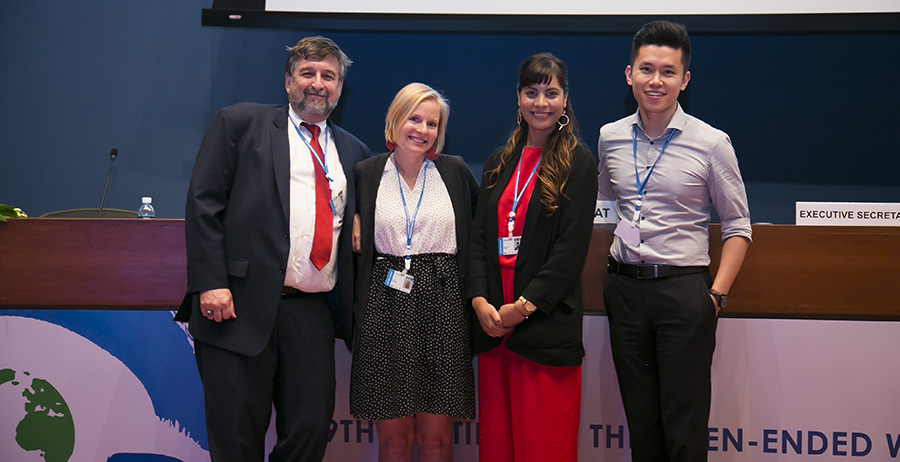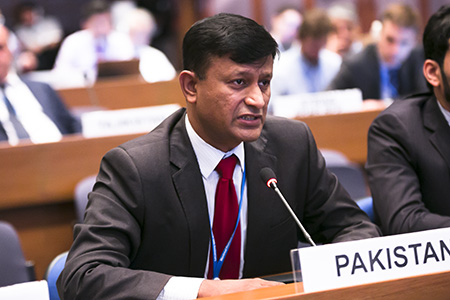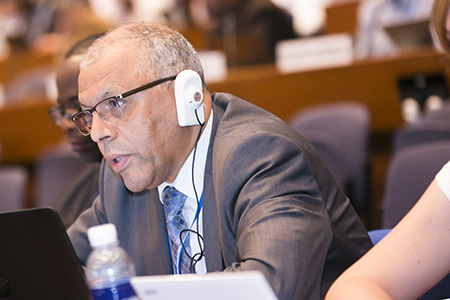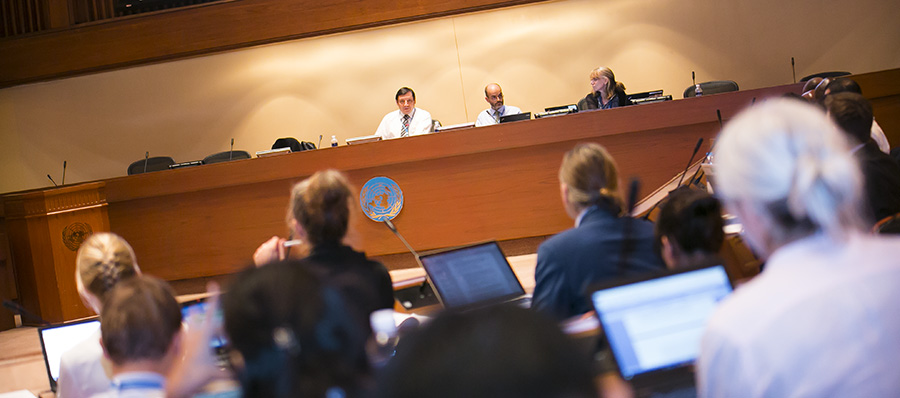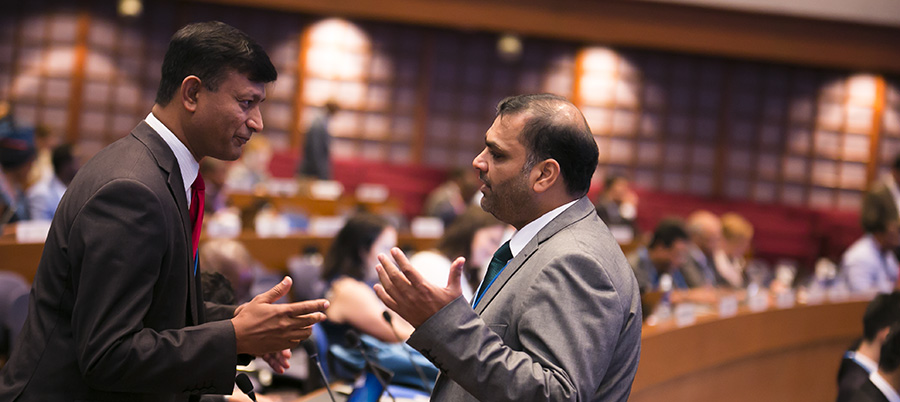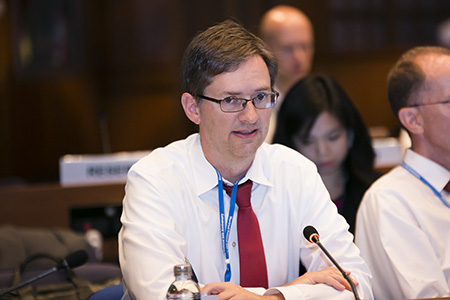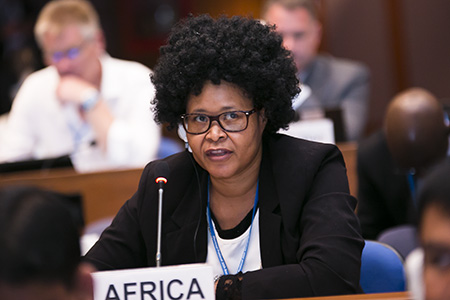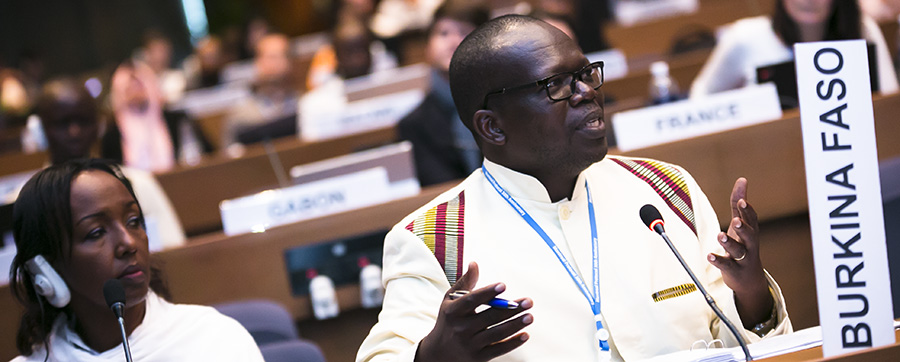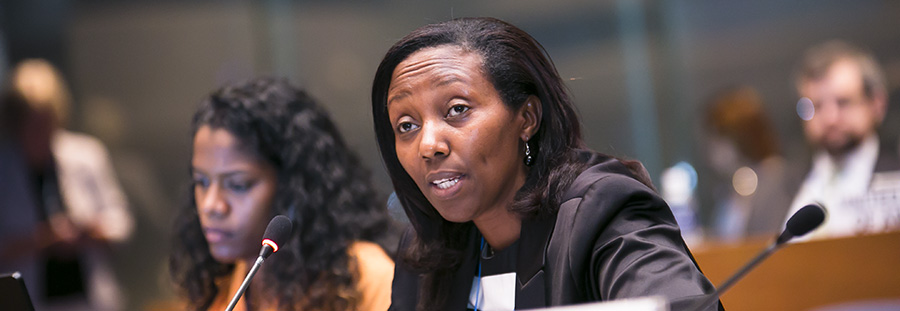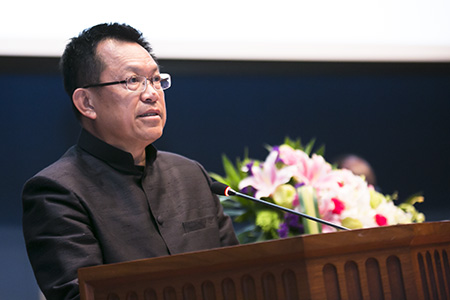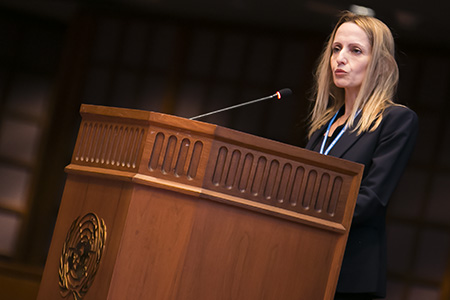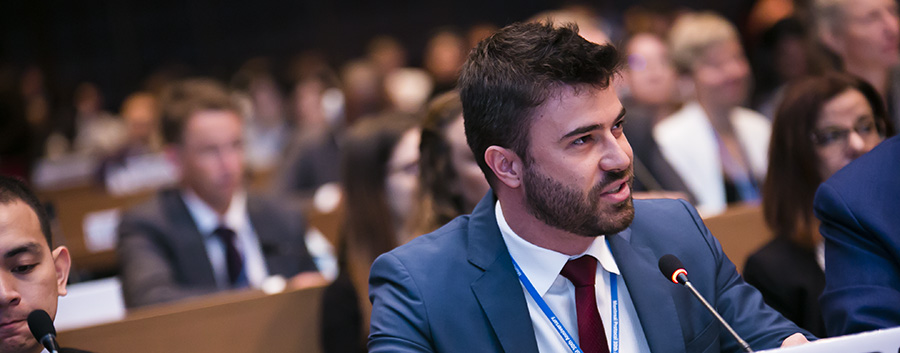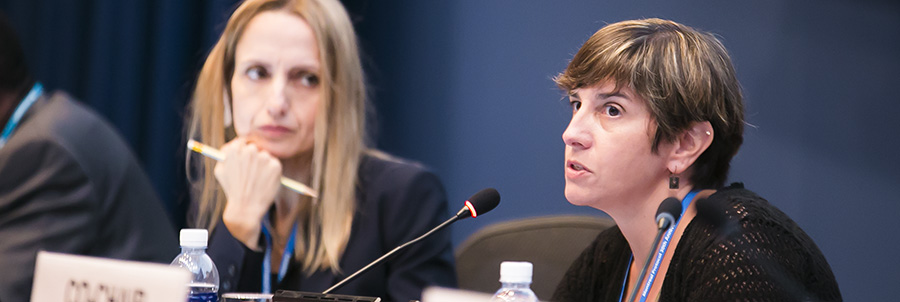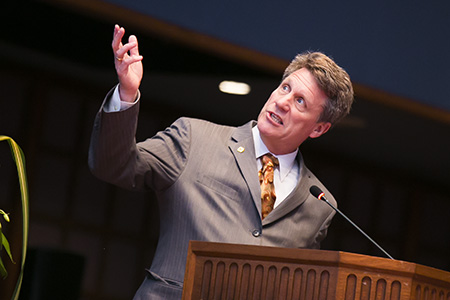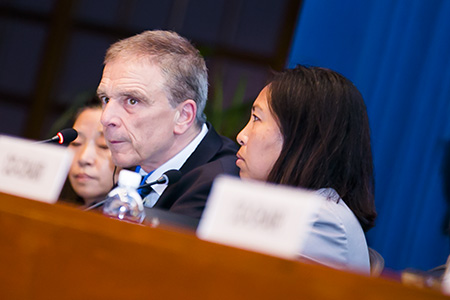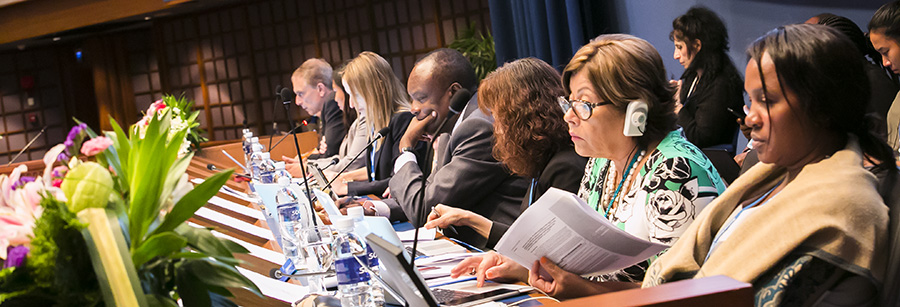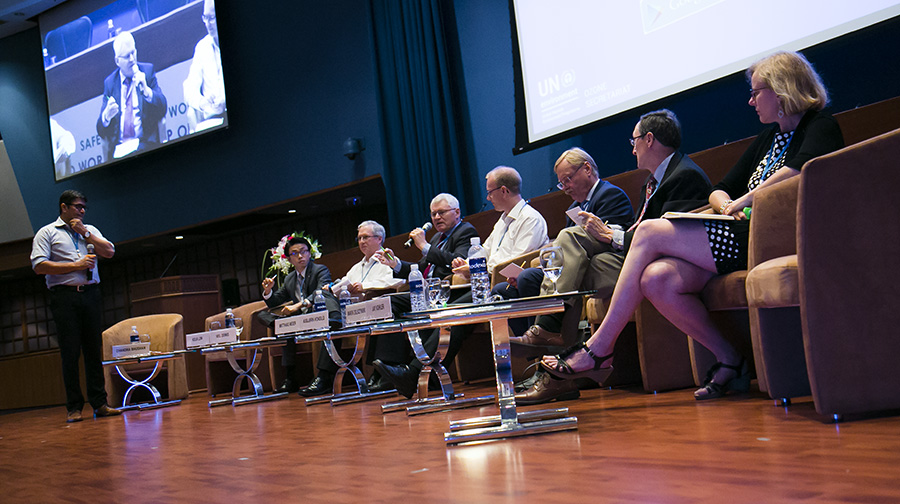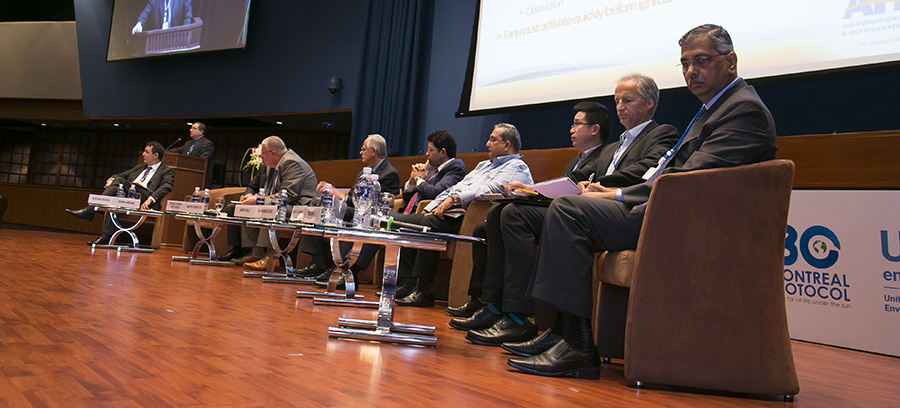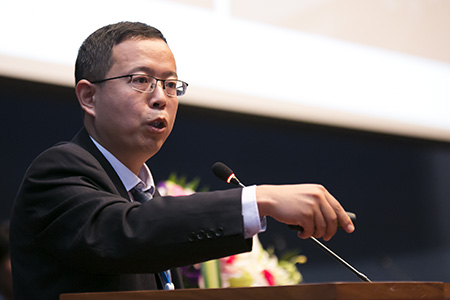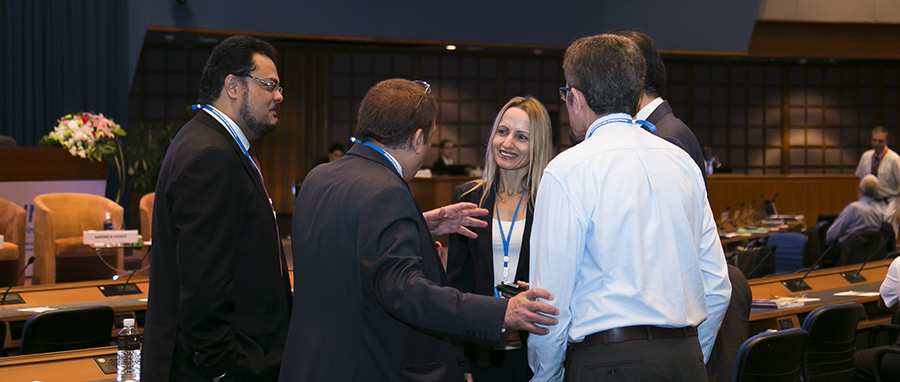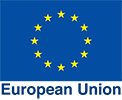Workshop on Safety Standards Relevant to the Safe Use of Low Global Warming Potential (GWP) Alternatives to Hydrofluorocarbons (HFCs) and 39th Meeting of the Open-ended Working Group (OEWG 39) of the Parties to the Montreal Protocol on Substances that Deplete the Ozone Layer
10-14 July 2017 | UN Conference Centre (UNCC), Bangkok, Thailand
Summary Highlights for the Meeting
Highlights for Friday, 14 July 2017
|
The morning plenary opened with progress reports from the contact groups and informal consultations. The plenary sent to the 29th Meeting of the Parties (MOP 29) a draft decision on essential uses of hydrochlorofluorocarbons (HCFCs) by non-Article 5 parties after 2020. After some debate, it also forwarded to the MOP a draft decision on energy efficient technical and financial assistance and a workshop on climate and energy co-benefits of the Montreal Protocol. Plenary suspended so that the two contact groups could continue their work through late afternoon. When the plenary reconvened, it agreed to forward several draft decisions on process agents, global warming potential (GWP) values for certain substances, destruction technologies for hydrofluorocarbons (HFCs), and a nomination for an essential-use exemption (EUE) for laboratory and analytical uses of carbon tetrachloride. The plenary also agreed on a list of items to be covered by the Technology and Economic Assessment Panel (TEAP) in its supplementary report to the MOP on funding needs for the 2018-2020 replenishment of the Multilateral Fund (MLF). It also agreed to defer further discussion on several other matters to the MOP, including data reporting issues and nominations for critical use exemptions (CUE) for methyl bromide uses. Co-Chair Sylla gaveled the meeting to a close at 6:22 PM. + Visit the web coverage for Friday, 14 July 2017 |
||
|
IISD Reporting Services, through its Earth Negotiations Bulletin (ENB) Meeting Coverage, has provided daily digital coverage and a summary and analysis report from the Workshop on the Safety Standards Relevant to the Safe Use of Low-GWP Alternatives to HFCs and OEWG 39. The summary and analysis report is now available in HTML and PDF. Photos by IISD/ENB | Sean Wu | ||
|
|
|
|
|
|
|
|
|
|
Highlights for Thursday, 13 July 2017
|
The thirty-ninth session of the Open-Ended Working Group of the Montreal Protocol (OEWG 39) convened for its third day in Bangkok, Thailand, on 13 July 2017. The morning plenary opened with progress reports from the contact groups on data and destruction technologies and on replenishment of the Multilateral Fund (MLF), as well as from informal consultations on nominations for essential use exemptions (EUEs) and critical use exemptions (CUEs). The delegates then discussed a conference room paper (CRP) on process agents before turning to debate two CRPs on energy efficiency, one on technical and financial assistance for Article 5 countries, the other on a possible workshop to discuss the Montreal Protocol's climate and energy co-benefits. The proponents of the two energy efficiency CRPs were asked to consult informally about a possible merger of their proposals. In the afternoon the contact groups met. The group on MLF replenishment worked on a list of information that parties wished to see in a supplementary report on the replenishment needs from the Technology and Economic Assessment Panel (TEAP) before 29th Meeting of the Parties (MOP 29) in November 2017. The group on data and destruction technologies focused principally on the remaining data reporting issues and the CRP on destruction technologies for hydrochlorocarbons (HFCs). An informal meeting was also held on a CRP regarding HFCs not listed in the Protocol's Annex F. + Visit the web coverage for Thursday, 13 July 2017 |
||
|
IISD Reporting Services, through its Earth Negotiations Bulletin (ENB) Meeting Coverage, has provided daily digital coverage and a summary and analysis report from the Workshop on the Safety Standards Relevant to the Safe Use of Low-GWP Alternatives to HFCs and OEWG 39. The summary and analysis report is now available in HTML and PDF. Photos by IISD/ENB | Sean Wu | ||
|
|
|
|
|
|
|
Highlights for Wednesday, 12 July 2017
|
The thirty-ninth session of the Open-Ended Working Group of the Montreal Protocol (OEWG 39) convened for its second day in Bangkok, Thailand, on Wednesday, 12 July 2017. In the morning, delegates discussed China’s nomination for an essential use exemption (EUE) for carbon tetrachloride in laboratory and analytical uses and six nominations from various parties for critical use exemptions (CUEs) involving methyl bromide. They also discussed process agents, Technical and Economic Assessment Panel (TEAP) organizational matters, and a proposal by four parties to request TEAP to assess non-Article 5 party requirements for use of hydrochlorofluorocarbons (HCFCs) for certain specific uses in the 2020-2030 period. They also heard the report of the workshop on safety standards relevant to the safe use of low global warming potential (GWP) alternatives to hydrofluorocarbons (HFCs) and the TEAP report on the same subject. In the afternoon, delegates debated possible follow-up regarding safety standards. They then discussed energy efficiency, as well as consideration of HFCs not listed in the Montreal Protocol's control annexes. + Visit the web coverage for Wednesday, 12 July 2017 |
||
|
IISD Reporting Services, through its Earth Negotiations Bulletin (ENB) Meeting Coverage, has provided daily digital coverage and a summary and analysis report from the Workshop on the Safety Standards Relevant to the Safe Use of Low-GWP Alternatives to HFCs and OEWG 39. The summary and analysis report is now available in HTML and PDF. Photos by IISD/ENB | Sean Wu | ||
|
|
|
|
|
|
Highlights for Tuesday, 11 July 2017
|
The thirty-ninth meeting of the Open-ended Working Group (OEWG 39) of the Parties to the Montreal Protocol on Substances that Deplete the Ozone Layer began on Tuesday, 11 July 2017, at the United Nations Conference Centre (UNCC) in Bangkok, Thailand, with opening remarks by Somchai Harnhiran, Ministry of Industry, Thailand, and Tina Birmpili, Executive Secretary, Ozone Secretariat. In the morning, delegates started discussions on Kigali Amendment implementation issues, including: data reporting under Protocol Article 7; work by the Scientific Assessment Panel (SAP) on updating the global warming potential (GWP) values for substances in the Protocol control annexes; and the process for approving destruction technologies for hydrofluorocarbons (HFCs). These items were referred to a contact group for further discussion. IIn the afternoon, delegates briefly took note of progress by the Executive Committee (ExCom) of the Multilateral Fund (MLF) in developing guidelines for financing the phase-down of HFC consumption and production, as requested by MOP 28. They then turned to the 2018-2020 MLF replenishment, starting with a presentation by the Technology and Economic Assessment Panel (TEAP) on its report on funding requirements. A contact group was formed to further discuss the replenishment. The afternoon ended with TEAP presenting its 2017 report, including issues relating to nominations for essential use exemptions (EUEs) and critical use exemptions (CUEs), quarantine and preshipment (QPS) uses of methyl bromide, methyl bromide stocks, hydrochlorofluorocarbons (HCFCs) phase-out, and organizational matters. In the evening, delegates attended a reception hosted by the Ozone Secretariat. + Visit the web coverage for Tuesday, 11 July 2017 |
||
|
IISD Reporting Services, through its Earth Negotiations Bulletin (ENB) Meeting Coverage, has provided daily digital coverage and a summary and analysis report from the Workshop on the Safety Standards Relevant to the Safe Use of Low-GWP Alternatives to HFCs and OEWG 39. The summary and analysis report is now available in HTML and PDF. Photos by IISD/ENB | Sean Wu | ||
|
|
|
|
|
|
|
|
|
Highlights for Monday, 10 July 2017
|
The one-day Workshop on Safety Standards Relevant to the Safe Use of Low Global Warming Potential (GWP) Alternatives to Hydrofluorocarbons (HFCs) convened on Monday, 10 July 2017, at the United Nations Conference Centre (UNCC) in Bangkok, Thailand. The Workshop was mandated by the 28th Meeting of the Parties (MOP 28) to the Montreal Protocol, held in Kigali, Rwanda, in October 2016. Its conclusions will be presented to the 39th Open-Ended Working Group (OEWG 39), which will meet in Bangkok after the workshop from 11-14 July 2017, for further consideration and discussion by the parties. Workshop participants were welcomed by Tina Birmpili, Executive Secretary, Ozone Secretariat, who outlined the fundamental questions to be addressed by the workshop. The workshop was divided into four sessions: an overview of the international safety standards of greatest importance to the Protocol and its Kigali Amendment and the process for developing and revising the standards; identifying limitations to the uptake of lower GWP alternatives that could be addressed with changes to existing international safety standards; the relationship between international and national safety standards; and how stakeholders can work together to maximize the opportunities for the safe use of lower GWP alternatives. At the end of the workshop, the rapporteurs for each session summarized key messages from their respective session. The set of key messages will be forwarded to OEWG 39 for its consideration. + Visit the web coverage for Monday, 10 July 2017 |
||
|
IISD Reporting Services, through its Earth Negotiations Bulletin (ENB) Meeting Coverage, has provided daily digital coverage and a summary and analysis report from the Workshop on the Safety Standards Relevant to the Safe Use of Low-GWP Alternatives to HFCs and OEWG 39. The summary and analysis report is now available in HTML and PDF. Photos by IISD/ENB | Sean Wu | ||
|
|
|
|
|
|
|
IISD Reporting Services is grateful to the many donors of the Earth Negotiations Bulletin (ENB) and recognizes the following as core contributors to the ENB: The EU and the Kingdom of Saudi Arabia. General Support for the Bulletin during 2017 is provided by the German Federal Ministry for the Environment, Nature Conservation, Building and Nuclear Safety (BMUB), the Italian Ministry for the Environment, Land and Sea, the Japanese Ministry of Environment (through the Institute for Global Environmental Strategies - IGES), the New Zealand Ministry of Foreign Affairs and Trade, the Swedish Ministry of Foreign Affairs, the Government of Switzerland (Swiss Federal Office for the Environment (FOEN), and SWAN International. Funding for translation of the Bulletin into French has been provided by the Government of France, Québec, and the International Organization of La Francophonie/Institute for Sustainable Development of La Francophonie (IOF/IFDD). |
||



